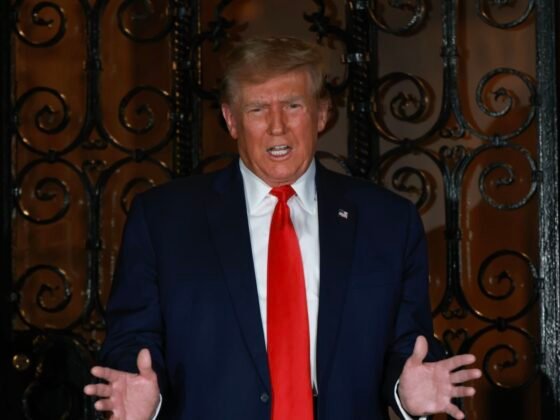Few would disagree. Lately, Allison’s work has ignited a revolution in oncology therapy that frees the immune system to assault malignant tumors. Sufferers close to demise have returned to reside full lives. The drug class he pioneered, referred to as checkpoint inhibitors, now features a half-dozen therapies which have spawned a billion-dollar market. So stuffed is his workplace with scientific awards that some sit in bins on the ground. He steadily exhibits up on the shortlist of contenders for the Nobel Prize in drugs, which is being introduced Monday.
However amid the successes, these are difficult occasions for Allison and the oncologist who’s his key accomplice – and who sometimes is entrance and middle within the viewers when his band performs at fundraisers like this. Padmanee Sharma is a formidable researcher and immunologist in her personal proper at MD Anderson, a specialist in renal, bladder and prostate cancers. She can also be Allison’s spouse.
Of their specific nook of the universe, they’re the last word energy couple. But they, like different immunotherapy fanatics, discover themselves grappling with the downsides of the brand new therapies. The therapies may cause severe negative effects and, whereas efficient for some sufferers, are removed from foolproof. And so they have largely been a bust for cancers of the prostate and pancreas.Allison and Sharma really feel the frustration acutely, saying that many extra folks should be helped. “We have to get the numbers a lot, a lot larger,” he says.
Whilst they pursue the following breakthrough, their lives are a frenetic mixture of science and movie star. Allison’s position in growing immunotherapy has received him the adulation of each sufferers and philanthropists. The couple has flown on philanthropist and former financier Michael Milken’s personal jet, been escorted on backstage excursions by U2’s the Edge and attended high-wattage Vatican stem-cell conferences. On the Smith & Wollensky’s the place they steadily dine in Houston – the place Allison proposed to Sharma – there are wall plaques inscribed with their names close to their traditional desk.
Nonetheless, they reserve most of their power for his or her science. They are saying immunotherapy’s downside is that its use in sufferers has outpaced a elementary understanding of the way it works.
To treatment that, they’re operating an formidable program that hyperlinks animal analysis, novel human trials and intense monitoring of tumors by way of repeated biopsies. By analyzing the malignancies earlier than, throughout and after therapy, they hope to raised perceive the interplay among the many most cancers, the therapy and the immune system. They know that utilizing combos of therapies for most cancers will in all probability be the important thing to raised outcomes for sufferers, however they want to determine precisely which medication to make use of, and the way.
Allison would not hesitate to inform Sharma what works finest for laboratory analysis. She pushes again on any strategies which may not assist sufferers, reminding Allison he is not a doctor.
And if they can not compromise, who wins?
“Pam,” says the gravelly voiced Allison. “She’s louder.”
“I simply need issues to maneuver issues quicker,” she counters.
—
On the sprawling MD Anderson campus, Sharma speed-walks, doling out medical recommendation, pep talks and the newest check outcomes.
She warmly greets Michael Lee Lanning, a retired Military lieutenant colonel who was identified with kidney most cancers in 2003. Inside three years, the illness had unfold all through his physique, and docs despatched him residence with painkillers and telephone numbers for hospice. He was 59.
In search of a reprieve, he went to MD Anderson and met Sharma. “She seemed me within the eye and mentioned, ‘Everybody will die, and a few will die sooner,’ ” he recalled. A “chilly b—-,” he instructed his spouse.
However as he ran by therapy after therapy, Lanning got here to understand Sharma’s refusal to surrender. Two years in the past, she had him enroll in a trial testing a mix of radiation and Yervoy, a medicine developed by Allison that was the primary checkpoint inhibitor permitted by the Meals and Drug Administration. The therapy stored Lanning’s most cancers below management till this previous December, when the tumors as soon as extra started rising and he repeated the one-two punch of radiation and Yervoy. Extra just lately, to maintain the tumors in examine, he started taking a distinct immunotherapy drug.
“I did not assume I might make it to 60,” mentioned Lanning, who’s once more secure. Now he is 71 years previous. His beloved granddaughter, who was eight when he was identified, is now in school.
Sharma has pushed for shut monitoring of tumors in varied levels of therapy for years, believing that it offers vital clues about why just some sufferers reply to immunotherapy and about tips on how to design subsequent trials and experiments. Allison, a fan of the technique, made its broad enlargement a situation of his transfer from Memorial Sloan Kettering Most cancers Heart in New York to MD Anderson in 2012. In the present day, about 100 of the middle’s trials contain such intense surveillance.
Whereas different most cancers hospitals do related evaluation, the dimensions of the hassle at MD Anderson units it aside. “I am jealous,” mentioned Charles Drake, co-director of the most cancers immunotherapy applications at Columbia College Medical Heart in New York. “They’ll apply state-of-the-art analytical instruments to tumor specimens earlier than, throughout and after therapies and see the ends in actual time.”
Now Sharma and Allison are bringing their method to superior prostate most cancers, which is notoriously immune to immunotherapy. Earlier analysis has proven that combining two immunotherapy medication is likely to be higher than utilizing only one. In a trial overseen by Sharma, one drug is used to drive T cells, the foot troopers of the immune system, to the tumor, and a second to dam proteins that hold these troopers from attacking the malignancy.
“We now have to attempt,” she says. “A minimum of these therapies give our sufferers an opportunity.”
—
By outward look, Allison and Sharma are opposites. She’s 47, putting and model-thin; he is 69, rumpled and pudgy.
Simply as pronounced are their similarities. They bonded years in the past over their shared obsession with T cells, and today, Sharma says, “we speak about information on a regular basis, at dinner, whereas brushing our enamel.”
Allison grew up in a small city in South Texas the place his country-doctor father made home calls. His mom died of lymphoma when he was 11 – simply the primary of many household losses to most cancers. Two uncles and a brother later died of the illness. Allison has battled early-stage melanoma, bladder and prostate cancers.
He went into most cancers analysis not due to household historical past however as a result of he all the time wished to be the primary individual to determine one thing out. Early on in lessons on the College of Texas at Austin, he realized that medical faculty wasn’t for him. “In case you are a physician, you need to do the precise factor; in any other case, you may damage someone,” he says. “I like being on the sting and being unsuitable lots.”
Allison didn’t attend medical faculty, however he did earn a PhD from the College of Texas at Austin. Within the mid-1990s, whereas doing analysis on the College of California at Berkeley, he grew to become intrigued by a molecule referred to as CTLA-Four, which exists on the floor of T cells. It was broadly thought to spur the immune system into motion. Allison and immunologist Jeffrey Bluestone on the College of California at San Francisco independently proved simply the alternative: The protein slammed on the immune system’s brakes.
Allison questioned in regards to the implications for most cancers. If this brake – referred to as a checkpoint – had been disabled, would T cells seek out and destroy tumors?
To seek out out, his lab developed an antibody that blocked CTLA-Four and injected it into mice with most cancers. The tumors melted away. That work led to a 1996 landmark paper describing a radical new anti-cancer method concentrating on the immune system, not the malignant cell. It was referred to as “checkpoint blockade.”
“Jim Allison’s conceptual perception opened up the entire subject,” mentioned Antoni Ribas, a number one oncologist and immunologist on the College of California at Los Angeles.
Allison was decided to get the compound into human testing. “I wasn’t going to let anybody get in my approach,” he says.
After years of badgering skeptical pharmaceutical corporations, he lastly persuaded an organization later purchased by Bristol-Myers Squibb to check the drug for superior melanoma, which on the time was virtually all the time deadly.
Sharon Vener, 65, was in one of many first trials. Within the mid-1980s, the mom of two had a small mole that turned out to be melanoma. Sixteen years later, the illness returned with a vengeance – as an inoperable, baseball-size tumor connected to her coronary heart, lungs and chest wall; she additionally had a number of tumors in her liver.
Her docs, together with Ribas, tried just a few therapies. All failed. As a ultimate effort, he enrolled her in a first-in-human trial of Allison’s immunotherapy drug. Her tumors started to shrink after a single dose.
“Each birthday, it is like, ‘Oh my God, I am nonetheless right here,’ ” Vener says. A decade in the past, Ribas launched her to Allison as the person who had saved her life. The 2 hugged after which cried.
—
Sharma’s father, an engineer in Guyana, ended up as a handyman after he and his household fled political turmoil for the USA in 1980. They settled in a tiny basement residence in “Little Guyana” in Queens, and her mom cleaned homes. Sharma was 10.
A standout scholar, she would go on to graduate from Boston College and earn a medical diploma and PhD in immunology from Pennsylvania State College. After additional coaching at Memorial Sloan Kettering Most cancers Heart in New York, she was employed by MD Anderson in 2004.
She and Allison met at a scientific assembly the next yr and commenced collaborating. For a very long time, she was leery about getting personally concerned with him. “I did not wish to fear that everybody would assume my concepts had been truly his concepts,” she says.
By now she has her personal vital achievements, together with being the primary to indicate T cell protein referred to as ICOS boosts the effectiveness of some immunotherapy. In Houston, each she and Allison have spectacular portfolios.
He’s chair of MD Anderson’s immunotherapy division and government director of what the most cancers middle calls its immunotherapy platform, a big effort to know most cancers and the immune system. She is the platform’s scientific director, and between the 2 of them they preside over three labs and dozens of individuals. Each week, they and their staff evaluate 4 or 5 trials to attempt to discern patterns, resolve which animal checks to conduct and tips on how to design new human research.
Of their private lives, the fixed discuss of T cells generally perplexes Sharma’s three daughters from a earlier marriage. However they’re accustomed to their mom’s focus. She says she has by no means felt responsible in regards to the calls for of her job; her sufferers desperately wanted her, and her daughters had been fortunate sufficient “to develop up wholesome in a world with indoor plumbing and Cheerios.”
Plus some perks: As of late, Sharma drives a Porsche with an arrogance license plate that claims CTLA-Four, a reference to her husband’s work. And he drives a Tesla with a plate that claims ICOS, a nod to hers.
—
However again to Chicago and the Home of Blues restaurant, the place the “The Checkpoints” are effectively into their set. The present, held yearly throughout the largest most cancers convention of the yr, raises cash for grants awarded by the Society for Immunotherapy of Most cancers.
Allison’s fame and his facility with the harmonica have supplied distinctive alternatives, resembling accompanying Willie Nelson and his band on the Redneck Nation Membership close to Houston. Tonight, nevertheless, clad in a black Hawaiian shirt, he is performing for a distinct crowd.
The massive boss man is the image of cool as he steps up and performs “Take Out Some Insurance coverage on Me, Child.” Dancing proper in entrance, as all the time, is Sharma.
(This story has not been edited by ZariNews workers and is auto-generated from a syndicated feed.)










